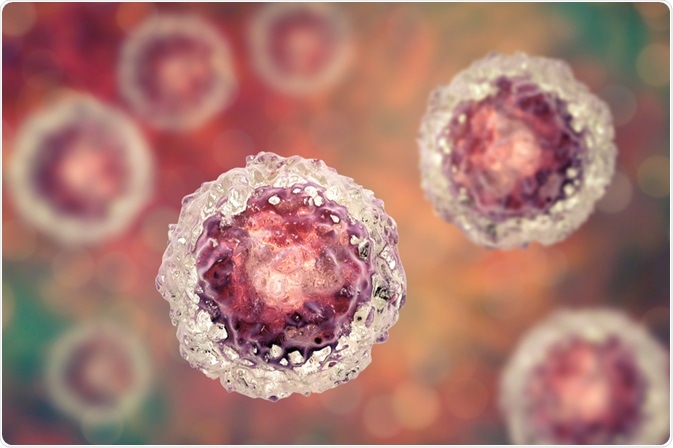What are pluripotent stem cells?
Stem cell research has become incredibly popular over the last few decades, with use in understanding disease, developing regenerative medicine techniques and testing the safety and efficacy of new drugs.
There are several types of stem cells; adult stem cells, perinatal stem cells, which can be donated from living adults, pluripotent stem cells are the most useful and these are harvested from embryos that are three to five days old.

Image Credit: Kateryna Kon/Shutterstock.com
Advancements in the field of stem cell research has been shrouded in controversy due to the origins of pluripotent stem cells which have caused ethical discussions.
Embryonic stem cells are most useful in the research as pluripotent stem cells have the potential to differentiate into any human cell or tissue.
Adult stem cells and perinatal stem cells are more limited in the types of cells that they are able to differentiate into. For this reason, the growth of applications of stem cells has focused on the use of pluripotent stem cells.
How to obtain pluripotent stem cells
In 1998, a scientist at the University of Wisconsin for the first time successfully removed pluripotent stem cells from embryos. Obtaining stem cells from unused or discarded embryos remains one of the main sources of pluripotent stem cells.
In mouse, parthenogenesis (self-fertilized) has been investigated as a method for obtaining embryonic stem cells. The parthenogenic embryonic stem cells were found to be able to differentiate into the fibroblastic lineage and may be a potential alternative to embryonic stem cells. Parthenogenic embryonic stem cells have also been created in humans and used to successfully derive neural stem cells.
Another method to obtain pluripotent stem cells is somatic cell nuclear transfer, where a donated human egg is combined with the nucleus of a non-sex cell from the body, usually a skin cell, to produce an embryonic stem cell.
Recently, there have been many advancements in the field of Induced Pluripotent Stem Cells (iPSCs), which was created to overcome the ethical issues related to the other forms of obtaining embryonic stem cells. iPSCs are made using transcription factors to reprogram somatic cells, so no embryo or donor egg is required.
Applications of pluripotent stem cells
Pluripotent stem cells are useful in modelling many aspects of disease, developmental pathways and reparative pathways.
Modeling human disease
Pluripotent stem cells can be used to model how human disease devlops and progresses. Stem cells can be observing maturing and differentiating over time into the essential cells, nerves, bone cells, and potentially organs that make up the human body.
Following the differentiation process enables key insights on how abnormalities arise and how they lead to disease which leads to the development of more effective preventions and treatments.
Regenerative medicine
One major application of pluripotent stem cells is within regenerative medicine. In the 1950s, stem cells have been used in bone marrow transplants in patients receiving radiation and chemotherapy for cancer.
Since then, research has expanded the use of pluripotent stem cells in regenerative medicine, so that it is now used in the treatment of an ever-growing list of illnesses and traumas, including spinal cord injuries, burns, type 1 diabetes, amyotrophic sclerosis, Parkinson’s disease, Alzheimer’s disease, stroke, cancer, heart disease, and osteoarthritis.
There has been research into the use of pluripotent stem cells for autologous grafts and transplants, pluripotent stem cells can be differentiated into new cells to replace diseased or damaged tissue within the human body.
As pluripotent stem cells have the potential to become any type of cell, their potential for use in regenerating tissue is almost unlimited.
Testing new drugs
Another valuable application of pluripotent stem cells is in the testing of new drugs using in vitro experiments, ensuring their safety and efficacy.
Stem cells allow researchers to monitor how new drugs impact particular cells and tissues before reaching the stage of human clinical trials. Drug testing is an emerging area of pluripotent stem cell use, it is predicted that it will have a major impact on improving the effectiveness of new drugs, reducing their potential toxicity and side effects.
Future directions
Pluripotent stem cells are already used in many applications and are vital in many therapeutic areas. In the future, it is likely that there will be further applications of pluripotent stem cells as research continues.
References:
- Abutaleb, N. O., & Truskey, G. A. (2020). Human iPSCs Stretch to Improve Tissue-Engineered Vascular Grafts. Cell Stem Cell, 26(2), 136-137.
- Chang, W. F., Wu, Y. H., Xu, J., & Sung, L. Y. (2019). Compromised Chondrocyte Differentiation Capacity in TERC Knockout Mouse Embryonic Stem Cells Derived by Somatic Cell Nuclear Transfer. International journal of molecular sciences, 20(5), 1236.
- Gonzalez, R., Garitaonandia, I., Semechkin, A., & Kern, R. (2019). Derivation of Neural Stem Cells from Human Parthenogenetic Stem Cells. In Neural Stem Cells (pp. 43-57). Humana Press, New York, NY.
- Rao, Y., Cui, J., Yin, L., Liu, W., Liu, W., Sun, M., ... & Chen, F. (2016). Preclinical study of mouse pluripotent parthenogenetic embryonic stem cell derivatives for the construction of tissue-engineered skin equivalent. Stem cell research & therapy, 7(1), 156.
- Romito, A., & Cobellis, G. (2016). Pluripotent Stem Cells: Current Understanding and Future Directions. Stem cells international, 2016, 9451492. https://doi.org/10.1155/2016/9451492
- Singh, V. K., Kalsan, M., Kumar, N., Saini, A., & Chandra, R. (2015). Induced pluripotent stem cells: applications in regenerative medicine, disease modeling, and drug discovery. Frontiers in cell and developmental biology, 3, 2.
- Tolosa, L., Pareja, E., & Gómez-Lechón, M. J. (2016). Clinical application of pluripotent stem cells: an alternative cell-based therapy for treating liver diseases?. Transplantation, 100(12), 2548-2557.
Further Reading